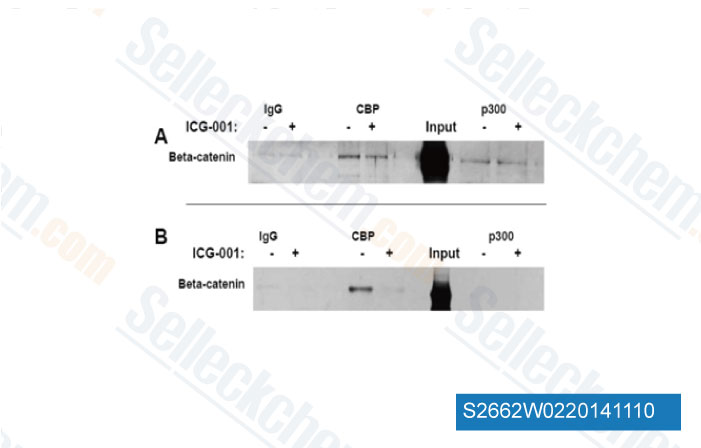|
Toll Free: (877) 796-6397 -- USA and Canada only -- |
Fax: +1-832-582-8590 Orders: +1-832-582-8158 |
Tech Support: +1-832-582-8158 Ext:3 Please provide your Order Number in the email. |
Technical Data
| Formula | C33H32N4O4 |
||||||||||
| Molecular Weight | 548.63 | CAS No. | 780757-88-2 (relative stereochemistry); 847591-62-2 (absolute stereochemistry) | ||||||||
| Solubility (25°C)* | In vitro | DMSO | 100 mg/mL (182.27 mM) | ||||||||
| Ethanol | 100 mg/mL (182.27 mM) | ||||||||||
| Water | Insoluble | ||||||||||
| In vivo (Add solvents to the product individually and in order) |
|
||||||||||
|
* <1 mg/ml means slightly soluble or insoluble. * Please note that Selleck tests the solubility of all compounds in-house, and the actual solubility may differ slightly from published values. This is normal and is due to slight batch-to-batch variations. * Room temperature shipping (Stability testing shows this product can be shipped without any cooling measures.) |
|||||||||||
Preparing Stock Solutions
Biological Activity
| Description | ICG-001 antagonizes Wnt/β-catenin/TCF-mediated transcription and specifically binds to CREB-binding protein (CBP) with IC50 of 3 μM, but is not the related transcriptional coactivator p300. ICG-001 induces apoptosis. | ||
|---|---|---|---|
| Targets |
|
||
| In vitro | ICG-001 has no effect on the related reporter construct, FOPFLASH, which contains mutated TCF sites. After treatment with 25μM of ICG-001 for 8 hours, SW480 cell reduces the steady-state levels of Survivin and Cyclin D1 RNA and protein, both of which can be up-regulated by β-catenin. ICG-001 selectively induces apoptosis in transformed cells but not in normal colon cells, reduces in vitro growth of colon carcinoma cells. [1] ICG-001, can phenotypically rescue normal nerve growth factor (NGF) -induced neuronal differentiation and neurite outgrowth in the presenilin-1 mutant cells, emphasizing the importance of the TCF/β-catenin signaling pathway on neurite outgrowth and neuronal differentiation. [2] A recent study demonstrates that 5μM ICG-001 inhibits leptin-induced EMT, invasion and tumorsphere formation in MCF7 cells. [3] |
||
| In vivo | Administration of a water-soluble analog of ICG-001 for 9 weeks reduces the formation of colon and small intestinal polyps by 42% as effectively as the nonsteroidal antiinflammatory agent Sulindac, which has consistently demonstrated efficacy in this model. No overt toxicity is detected throughout the course of treatment. In the SW620 nude mouse xenograft model of tumor regression, 150 mg/kg, i.v. of analog demonstrates a dramatic reduction in tumor volume over the 19-day course of treatment, with no mortality or weight loss. [1] ICG-001 (5 mg/kg per day) significantly inhibits beta-catenin signaling and attenuates bleomycin-induced lung fibrosis in mice, while concurrently preserving the epithelium. [4] |
Protocol (from reference)
| Kinase Assay: |
|
|---|---|
| Cell Assay: |
|
| Animal Study: |
|
References
Customer Product Validation

-
Data from [Data independently produced by Mol Cancer Ther, 2014, 13(10), 2303-14]

-
Data from [J Biol Chem, 2013, 56(4), 423-33]

-
Data from [Data independently produced by J Cancer, 2013, 4(6), 481-90]

-
Data from [Mol Immunol, 2013, 56(4), 423-33]
Selleck's ICG-001 has been cited by 187 publications
| The EIF3H-HAX1 axis increases RAF-MEK-ERK signaling activity to promote colorectal cancer progression [ Nat Commun, 2024, 15(1):2551] | PubMed: 38514606 |
| Tumor-derived Exosomal ENO2 Modulates Polarization of Tumor-associated Macrophages through Reprogramming Glycolysis to Promote Progression of Diffuse Large B-cell Lymphoma [ Int J Biol Sci, 2024, 20(3):848-863] | PubMed: 38250157 |
| Farnesoid X receptor activation protects against renal fibrosis via modulation of β-catenin signaling [ Mol Metab, 2024, 79:101841] | PubMed: 38036169 |
| Establishment, characterization, and biobanking of 36 pancreatic cancer organoids: prediction of metastasis in resectable pancreatic cancer [ Cell Oncol (Dordr), 2024, 10.1007/s13402-024-00939-5] | PubMed: 38619751 |
| The E156K mutation in the CRYAA gene affects the epithelial-mesenchymal transition and migration of human lens epithelial cells [ Heliyon, 2024, 10(1):e23690] | PubMed: 38187316 |
| Zinc oxide nanoparticles inhibit osteosarcoma metastasis by downregulating β-catenin via HIF-1α/BNIP3/LC3B-mediated mitophagy pathway [ Bioact Mater, 2023, 19:690-702] | PubMed: 35600978 |
| Gain-of-function mutant p53 together with ERG proto-oncogene drive prostate cancer by beta-catenin activation and pyrimidine synthesis [ Nat Commun, 2023, 14(1):4671] | PubMed: 37537199 |
| CDK5RAP2 is a Wnt target gene and promotes stemness and progression of oral squamous cell carcinoma [ Cell Death Dis, 2023, 14(2):107] | PubMed: 36774351 |
| Regulation of the WNT-CTNNB1 signaling pathway by severe fever with thrombocytopenia syndrome virus in a cap-snatching manner [ mBio, 2023, e0168823.] | PubMed: 37882780 |
| Inhibiting CBP Decreases AR Expression and Inhibits Proliferation in Benign Prostate Epithelial Cells [ Biomedicines, 2023, 11(11)3028] | PubMed: 38002029 |
RETURN POLICY
Selleck Chemical’s Unconditional Return Policy ensures a smooth online shopping experience for our customers. If you are in any way unsatisfied with your purchase, you may return any item(s) within 7 days of receiving it. In the event of product quality issues, either protocol related or product related problems, you may return any item(s) within 365 days from the original purchase date. Please follow the instructions below when returning products.
SHIPPING AND STORAGE
Selleck products are transported at room temperature. If you receive the product at room temperature, please rest assured, the Selleck Quality Inspection Department has conducted experiments to verify that the normal temperature placement of one month will not affect the biological activity of powder products. After collecting, please store the product according to the requirements described in the datasheet. Most Selleck products are stable under the recommended conditions.
NOT FOR HUMAN, VETERINARY DIAGNOSTIC OR THERAPEUTIC USE.
